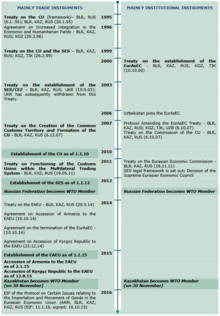
The Commonwealth of Independent States (CIS) is a regional intergovernmental organization in Eurasia. It was formed following the dissolution of the Soviet Union in 1991, and is its legal successor. It covers an area of 20,368,759 km2 (7,864,422 sq mi) and has an estimated population of 246,200,194. The CIS encourages cooperation in economic, political, and military affairs and has certain powers relating to the coordination of trade, finance, lawmaking, and security, including cross-border crime prevention.

A trade agreement is a wide-ranging taxes, tariff and trade treaty that often includes investment guarantees. It exists when two or more countries agree on terms that help them trade with each other. The most common trade agreements are of the preferential and free trade types, which are concluded in order to reduce tariffs, quotas and other trade restrictions on items traded between the signatories.
European integration is the process of industrial, economic, political, legal, social, and cultural integration of states wholly or partially in Europe, or nearby. European integration has primarily but not exclusively come about through the European Union and its policies.

The Union State of Russia and Belarus, officially also referred to as simply Union State, is a supranational union consisting of Belarus and Russia, with the stated aim of deepening the relationship between the two states through integration in economic and defence policy. Originally, the Union State aimed to create a confederation; however, both countries currently retain their independence.

The Eurasian Economic Community was a regional organisation between 2000 and 2014 which aimed for the economic integration of its member states. The organisation originated from the Commonwealth of Independent States (CIS) on 29 March 1996, with the treaty on the establishment of the Eurasian Economic Community signed on 10 October 2000 in Kazakhstan's capital Astana by Presidents Alexander Lukashenko of Belarus, Nursultan Nazarbayev of Kazakhstan, Askar Akayev of Kyrgyzstan, Vladimir Putin of Russia, and Emomali Rahmon of Tajikistan. Uzbekistan joined the community on 7 October 2005, but later withdrew on 16 October 2008.
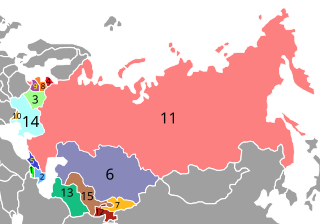
The post-Soviet states, also referred to as the former Soviet Union (FSU) or the former Soviet republics, are the independent sovereign states that emerged/re-emerged from the dissolution of the Soviet Union in 1991. Prior to their independence, they existed as Union Republics, which were the top-level constituents of the Soviet Union. There are 15 post-Soviet states in total: Armenia, Azerbaijan, Belarus, Estonia, Georgia, Kazakhstan, Kyrgyzstan, Latvia, Lithuania, Moldova, Russia, Tajikistan, Turkmenistan, Ukraine, and Uzbekistan. Each of these countries succeeded their respective Union Republics: the Armenian SSR, the Azerbaijan SSR, the Byelorussian SSR, the Estonian SSR, the Georgian SSR, the Kazakh SSR, the Kirghiz SSR, the Latvian SSR, the Lithuanian SSR, the Moldavian SSR, the Russian SFSR, the Tajik SSR, the Turkmen SSR, the Ukrainian SSR, and the Uzbek SSR. In Russia, the term "near abroad" is sometimes used to refer to the post-Soviet states other than Russia.
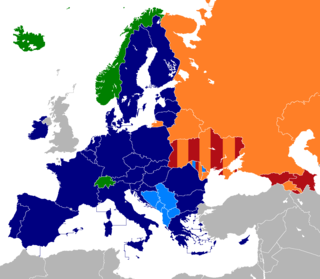
At present, there are six multi-lateral free trade areas in Europe, and one former free trade area in recent history. Note that there are also a number of bilateral free trade agreements between states and between trade blocks; and that some states participate in more than one free trade area.

The Collective Security Treaty Organization (CSTO) is an intergovernmental military alliance in Eurasia consisting of six post-Soviet states: Armenia, Belarus, Kazakhstan, Kyrgyzstan, Russia, and Tajikistan, formed in 2002. The Collective Security Treaty has its origins in the Soviet Armed Forces, which was replaced in 1992 by the United Armed Forces of the Commonwealth of Independent States, and was then itself replaced by the successor armed forces of the respective independent states.

The Single Economic Space Agreement (SES) or Common Economic Zone Agreement (CEZ) is an international agreement on the intention to create conditions for the free movement of goods, services, capital and labor without the creation of supranational bodies, signed on 19 September 2003 by Belarus, Kazakhstan, the Russian Federation and Ukraine. Initially this project was a separate one, but in June 2006, the implementation of this project was incorporated into the Eurasian Economic Community.

Treaty on Free Trade Area is an international treaty on a free trade regime in goods signed by eight post-Soviet states on 18 October 2011, at a meeting of the Commonwealth of Independent States (CIS) Council of Heads of Government in St. Petersburg and entered into force on 20 September 2012. It creates Free Trade Area among Russia, Ukraine, Belarus, Moldova, Armenia, Kyrgyzstan, Kazakhstan and Tajikistan. This treaty and other agreements within the Commonwealth of Independent States do not regulate relations with third countries, the terms of the CIS FTA allow member states to enter into the FTA agreements with other countries, as well as to join/create custom unions.

The Eurasian Economic Union is an economic union of five post-Soviet states located in Eurasia. The EAEU has an integrated single market. As of 2023, it consists of 183 million people and a gross domestic product of over $2.4 trillion.

The Customs Union of the Eurasian Economic Union or EAEU Customs Union is a customs union of 5 post-Soviet states consisting of all the member states of the Eurasian Economic Union which initially became effective on January 1, 2010 at the date of implementation of the common external tariff (CET) as the Customs Union of the Eurasian Economic Community or Customs Union of Russia, Belarus and Kazakhstan. It was inherited from the Eurasian Economic Community and is now regulated by Part Two of the Treaty on the Eurasian Economic Union, EAEU Customs Code, other international agreements and by decisions of supranational bodies as Supreme Eurasian Economic Council, Intergovernmental Council and Eurasian Economic Commission.
The Eurasian Economic Commission (EEC) is the executive body of the Eurasian Economic Union responsible for implementing decisions, upholding the EEU treaties and managing the day-to-day business of the Eurasian Economic Union. The main task of the Eurasian Economic Commission is to ensure the functioning and development of the EEU, and to prepare proposals for its further integration.
The future enlargement of the Eurasian Economic Union is theoretically open to any of the post-Soviet states and potentially any country of Europe or Asia. In order to accede, a state must fulfill certain economic and political requirements. Enlargement of the Eurasian Economic Union is also subject to the consent of all existing members and the candidate's adoption of existing EEU laws and implementing previous decisions made by the Eurasian Economic Commission. The present agenda of the enlargement of the Eurasian Economic Union is primarily focused on Tajikistan. Meanwhile, Moldova was granted Observer Status in April 2017, followed by Uzbekistan and Cuba in December 2020. The process of enlargement is referred to as Eurasian integration or Eurasianism. This term is also used to refer to the intensification of economic cooperation between Eurasian Economic Union member states.

The Eurasian Economic Union (EEU) currently comprises 5 member states, which are party to the founding treaties of the EEU and thereby subject to the privileges and obligations of membership. The constituent states of the EEU are placed under binding laws and have equal representation within the EEU's executive and judicial bodies. They do however retain considerable autonomy, and must be unanimous for the EEU to adopt policies or new member states. Consensus is a founding principle of the EEU.
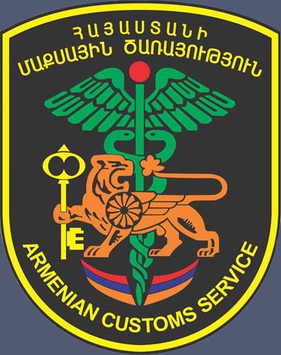
The Armenian Customs Service is a subsidiary department of the State Revenue Committee responsible for customs services on behalf of the Armenian government, headquartered in Yerevan.
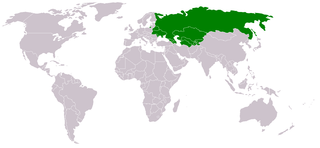
The Agreement on the Establishment of a Free Trade Area is an international agreement on the intention to create a free trade regime in goods signed by 12 post-Soviet states on 15 April 1994, at a meeting of the Commonwealth of Independent States (CIS) Council of Heads of State in Moscow and entered into force on December 30, 1994. Article 1 indicated that this was "the first stage of the creation of the Economic Union", but on 2 April 1999 the countries agreed to remove this phrase from the agreement. Article 17 also confirmed the intention to conclude a free trade agreement in services.
The Agreement on Free Trade in Services, Establishment, Operations and Investment is an international agreement on the creation a free trade regime in services and investment signed by 7 post-Soviet states namely Russia, Armenia, Belarus, Kyrgyzstan, Kazakhstan, Tajikistan and Uzbekistan on 8 June 2023, at a meeting of the Commonwealth of Independent States (CIS) in Sochi, Russia to partly integrate Uzbekistan and Tajikistan on the common standards of the WTO and the EAEU even without their membership in the WTO (Uzbekistan) or the EAEU. It entered into force for Kyrgyzstan, Belarus and Tajikistan on 5 June 2024. It entered into force for Russia on 24 July 2024. On 14 October 2024, Armenia notified of its ratification of the Agreement and it enters into force for Armenia on 13 November 2024.

Eurasian economic integration is the process of economic integration of post-Soviet states which are geographically located in the center of the continent of Eurasia. Eurasian integration has been taking shape since 1991, originally via the establishment of the Commonwealth of Independent States in 1991, as noted in the World Trade Organization report. Currently, integration is primarily implemented through organizations that are open to accession by any post-Soviet countries, such as the Commonwealth of Independent States and the Eurasian Economic Union. An economic union means the deepest stage of economic integration.

The Common Economic Space is the goal and the result of the process of economic integration of post-Soviet states envisaged by the Article 7 of the Agreement on the creation the Commonwealth of Independent States signed on 8 December 1991. According to Article 7, the High Contracting Parties indicate that through common coordinating institutions, their joint activities will consist in coordinating foreign policy activities, cooperation in the formation and development of a common economic space, common European and Eurasian markets, in the field of customs policy, in the development of transport and communication systems, cooperation in the field of environmental protection, migration policy and the fight against organized crime.

